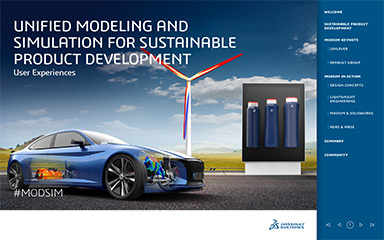Latest News
December 2, 2019
There’s the driving talent and the engineering team, of course. But the under-rated MVP of Richard Childress Racing (RCR) might just be the expanding use of simulation and the digital twin as way to fast track performance of its race car fleet.
Simulation software has long played a role, but advances in the software suites, coupled with the continuing declining cost of raw computing power, have positioned it squarely as a co-pilot on the racing circuit. While the RCR engineering team has been using Finite Element Analysis (FEA) software to optimize the structural integrity of parts, the use cases have exploded over the years to include Computational Fluid Dynamics (CFD) to aid in aerodynamics optimization as well as the nascent digital twin and multiphysics simulation to model a full-scale race car along with its behavior. In addition, Product Lifecycle Management (PLM) platforms are employed to help manage design and production across a full assembly, according to Eric Warren, RCR’s chief technology officer.
“Being able to evaluate a design, given the accuracy of simulation tools, enables you to develop a car more cheaply and efficiently,” he explains. “Now we’re not just evaluating aerodynamics by itself, but looking at its effect on the car as a system. Being able to simulate all of that gives us the flexibility of optimizing the external aerodynamics … and understanding the car better.”
Having better insight into a car’s performance is critical to the racing process. The NASCAR governing body lays out a set of rules to create an even playing field, and it falls on the independent teams to do their best to optimize the vehicles within the spirit of those rules. “In NASCAR, it’s a badge of honor to figure out how to get around the rules and use technology to beat the process,” Warren says. “We are constantly working on ways to be more efficient and use our budgets in the best way.”

That’s where modern-day simulation comes into play. The ANSYS simulation suite helps RCR engineers be more efficient with race car designs in three ways: They gain a better understanding of how parts work together; they are able to iterate on items faster and more cheaply than with a physical prototyping and test process; and they can be more aggressive in pushing performance behaviors with the added boost from simulation.
Currently, RCR is working with ANSYS on more advanced CFD simulation problems. The partners are developing a workflow that automates CFD and adjoint-based analysis for faster response times for modifying surfaces as part of aerodynamics optimization. “Think of it as topology optimization for aerodynamics—you move the surface and the simulation software optimizes the surface for some cost function or objective function,” Warren says.

Not only is digital testing less expensive than physical wind tunnel or race track testing, it also is far less restrictive, Warren says. “Simulation allows you to understand not only the overall drag on a car, but what the wind flow looks like as it passes the driver windows or how the air flows across the grill. All these things are extremely difficult to test in reality.”
RCR does have more latitude with virtual testing compared to traditional automotive makers, Warren admits. “While we want to be accurate, as long as it’s directionally correct, we’re okay,” he says. “We don’t have to spend years of correlating between simulation and wind tunnel tests. We still want some traceability and to understand how assumptions get made, but the cycle to go back and fix that is easier for us than for a car company that would have to recall a million vehicles.”
To learn more about how RCR leverages ANSYS simulation, tune into this webinar.
More Ansys Coverage
More Rescale Coverage

Subscribe to our FREE magazine, FREE email newsletters or both!
Latest News
About the Author
Beth Stackpole is a contributing editor to Digital Engineering. Send e-mail about this article to DE-Editors@digitaleng.news.
Follow DE






